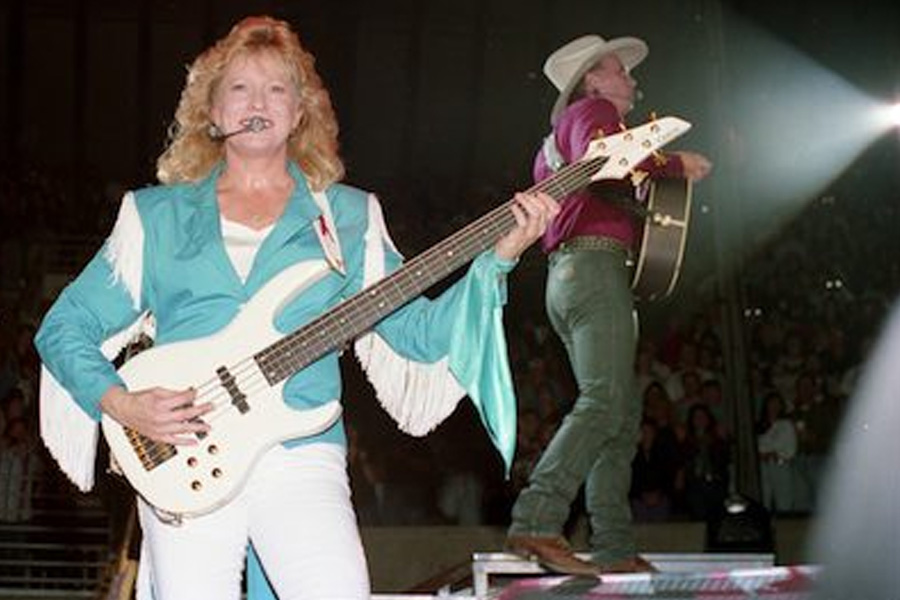Basic Information
| Field | Detail |
|---|---|
| Full Name | Harriett Elizabeth “Betsy” Smittle |
| Known As | Betsy Smittle; nickname “Hollywood” |
| Birth | February 3, 1953 — Tulsa, Oklahoma |
| Death | November 2, 2013 — age 60, at home in Oklahoma |
| Cause of Death | Ovarian cancer (diagnosed circa 2011) |
| Education | Yukon High School, Class of 1971 |
| Occupation | Musician (bass guitarist, vocalist) |
| Instruments | Bass guitar, guitar, vocals |
| Genres | Country, blues, rock |
| Years Active | 1970s–2013 |
| Associated Acts | Garth Brooks; Tulsa music scene (Anne Bell, Gus Hardin, Leon Russell, Ronnie Dunn) |
| Notable Releases | Solo album “Rough Around the Edges” (1994) |
| Notable Contributions | Touring bassist/vocalist during Garth Brooks’ 1990–1995 peak; influence on “We Shall Be Free” era (1992) |
| Parents | Colleen Carroll (mother); James Perry Smittle (father); Troyal Raymond Brooks (stepfather) |
| Siblings | A blended family of five brothers; close with half-brother Garth Brooks |
| Partner | Valerie Meador (Tulsa, Oklahoma) |
| Residence Ties | Tulsa and Yukon, Oklahoma |
| Personal Notes | Openly lesbian; advocate for LGBTQ+ rights; animal lover and gardener |
Early Life and Roots in Oklahoma
Born in Tulsa on February 3, 1953, Betsy Smittle grew up in a household where melody was a second language. Her mother, Colleen Carroll, sang country on national stages in the 1950s; her father, James Perry Smittle, played fiddle in Colleen’s band. When Colleen remarried in 1957 to oil draftsman Troyal Raymond Brooks, the family blended—six children under one roof by the late 1960s, and Betsy the only girl in a boisterous crowd of brothers.
In 1966, the family moved to Yukon, Oklahoma. Betsy graduated from Yukon High School in 1971, remembered as a “jock” with a competitive streak and a singular ear for harmony. Guitar lessons from her father and the example set by her mother’s stagecraft laid the foundation for a working musician’s life—less the spotlight, more the steady heartbeat of a band’s low end.
A Working Musician’s Path: 1970s–2013
After high school, Betsy returned to Tulsa’s vibrant clubs and studios, a regional scene buzzing with crossover energy. During the late 1970s and 1980s, she performed with noted Oklahoma talents—Anne Bell, Gus Hardin, Leon Russell, and a pre-Brooks & Dunn Ronnie Dunn—accruing a reputation as a dependable bassist with soulful, blues-steeped vocals.
The 1990s lifted her into arenas. From roughly 1990 to 1995, she toured as a bassist and backing vocalist with her half-brother Garth Brooks at the precise moment country music went stadium-sized. She shared the road during the eras of blockbuster albums—Ropin’ the Wind (1991), The Chase (1992), In Pieces (1993), Fresh Horses (1995)—and the juggernaut live moment captured later on Double Live (1998). Onstage, Garth called her “Hollywood” for her flair and presence; she called it a dream realized, playing to tens of thousands night after night.
In 1994, Betsy released her solo album, Rough Around the Edges, a blend of country grit, blues mood, and soft-rock polish. Its emotional core is “This House,” a duet with her mother—a semi-autobiographical diary in song that bridges generations. Though underpromoted and hard to find in the U.S. for years, the record became a treasured artifact among Tulsa music devotees and Garth’s fan community.
Highlights snapshot:
- 1971: Graduates from Yukon High School.
- 1970s–1980s: Tulsa club circuit; collaborations with regional names.
- 1990–1995: Tours with Garth Brooks at the height of his ascent.
- 1992: Era of “We Shall Be Free,” a civil-rights anthem Garth linked to Betsy’s influence.
- 1994: Releases Rough Around the Edges.
Selected Credits and Milestones
| Year | Project/Period | Role |
|---|---|---|
| Late 1970s–1980s | Tulsa circuit (Anne Bell, Gus Hardin, Leon Russell, Ronnie Dunn) | Bassist, backing vocalist |
| 1990–1995 | International touring with Garth Brooks | Bassist, backing vocalist |
| 1991–1995 | Ropin’ the Wind; The Chase; In Pieces; Fresh Horses (tour eras) | Live support during album cycles |
| 1994 | Rough Around the Edges (solo album) | Lead vocalist, songwriter, bassist |
| 1998 | Double Live (tour era culmination) | Live-era contributor (touring band alumna) |
Family Ties: The Blended Brooks–Smittle Clan
Music was both inheritance and glue. Betsy’s mother, Colleen Carroll (1929–1999), had recorded for Capitol Records in the 1950s, appearing on television and imprinting a career path on her children. Betsy’s father, James Perry Smittle, taught her guitar and modeled the working musician’s ethic. Her stepfather, Troyal Raymond Brooks, provided a steady keel as the family settled in Yukon.
Betsy was close to all her brothers, but her bond with Garth was singular—creative collaboration, life on the road, and shared values. The family spread across Oklahoma, Tennessee, and Missouri, gathering around milestones and, ultimately, around Betsy’s final months.
| Family Member | Relationship | Notes |
|---|---|---|
| Colleen Carroll (McElroy) Brooks (1929–1999) | Mother | 1950s country singer; duetted with Betsy on “This House.” |
| James Perry Smittle I | Father | Fiddle player; taught Betsy guitar; predeceased her. |
| Troyal Raymond Brooks | Stepfather | Oil company draftsman; helped raise the blended family; predeceased Betsy. |
| Jim Smittle | Brother | Older brother in Owasso, Oklahoma; married to Teri. |
| Jerry “Jerome” Smittle (deceased) | Half-brother (shared mother) | Predeceased Betsy; remembered as family-focused. |
| Mike Brooks | Half-brother | Based in Newburg, Missouri; married to Mary. |
| Kelly Brooks | Half-brother | Nashville-based; married to Lisa; tour director for Garth Brooks. |
| Garth Brooks (b. 1962) | Half-brother | Country superstar; married to Trisha Yearwood; close collaborator with Betsy. |
| Valerie Meador | Life partner | Tulsa-based; kept a private life with Betsy. |
| Extended Family | Nieces/Nephews | 12 nieces/nephews and 19 great-nieces/nephews. |
Advocacy, Identity, and Influence
Openly lesbian in a genre and era not always welcoming to queer artists, Betsy chose candor over camouflage. She performed at pride events across the South, lent her voice and presence to inclusive causes, and became a touchstone for fans seeking representation. Her life and conversations influenced Garth Brooks’s public stance on equality—resonating in his 1992 anthem “We Shall Be Free” and in later public advocacy for same-sex marriage. Betsy’s visibility was quiet but seismic, like a bassline that reshapes the song without stealing its spotlight.
Legacy, Tributes, and Remembrance
Betsy battled ovarian cancer for roughly two years and died peacefully at home on November 2, 2013, at age 60, surrounded by family and friends. Per her wishes, no funeral was held. The Oklahoma music community honored her impact through stories, playlists, and gatherings. In 2022, Tulsa’s Cain’s Ballroom hosted a “Women of Song” tribute that included Betsy alongside Gus Hardin and Debbie Campbell—an evening of memory and melody, nodding to the women who helped define the city’s sound.
Mentions of Betsy in 2023–2024 social media threads often tie to Garth’s continued advocacy, recalling her as a compass for his beliefs and a trailblazer in a conservative corner of American music. Her legacy lives in the people she mentored, the stages she steadied, and the artists—famous and unsung—who found courage in her example.
Financial Footprint
Public records do not substantiate any reliable estimate of Betsy Smittle’s net worth. As a supporting musician, her earnings likely came from touring, studio work, local performances, and her 1994 solo album—modest by superstar standards, consistent with a life built more around craft and community than accumulation.
FAQ
When and where was Betsy Smittle born?
She was born on February 3, 1953, in Tulsa, Oklahoma.
How did Betsy Smittle die?
She passed away from ovarian cancer on November 2, 2013, after a roughly two-year battle.
What instruments did she play?
Primarily bass guitar, along with guitar and vocals.
What was her role with Garth Brooks?
From 1990 to 1995, she toured as a bassist and backing vocalist during his arena-sized rise.
Did she release any solo music?
Yes, her solo album “Rough Around the Edges” was released in 1994.
Was Betsy Smittle involved in LGBTQ+ advocacy?
Yes, she was openly lesbian, performed at pride events, and influenced Garth Brooks’s public support for equality.
Who were her parents?
Her mother was 1950s country singer Colleen Carroll; her father was musician James Perry Smittle; her stepfather was Troyal Raymond Brooks.
Did she have children?
No children are mentioned in public records; she is remembered by a large extended family.



